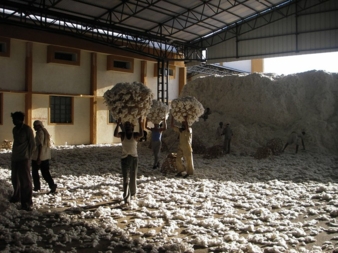30/11/2020 – Cotton in India — auf Deutsch lesen
Production affected by heavy rains
According to rainfall data published by the Indian Meteorological Department, excess rains in major cotton growing states have led to flooding of crop areas.
USDA/FAS* post estimates India’s cotton production at 6.4 million tonnes (29.3 million 480-lb bales) for season 2020/21 on an area of 13 million hectares. Post’s area estimate is 400,000 hectares lower than the official USDA estimate, resulting in a reduction of 800,000 480 lb. bales in Post’s production estimate. Post’s production estimate has been revised due to the lower expected yields as a result of heavy rains across major cotton growing states. National average yields are estimated around 491 kilograms per hectare, which is 2 percent higher than last year.
Risk of flower and square dropping
According to rainfall data published by the Indian Meteorological Department, excess rains in major cotton growing states of Maharashtra, Gujarat, Telangana, Karnataka and Andhra Pradesh have led to flooding/water logging of crop areas, adversely impacting cotton crop development. Due to excess soil moisture, there is greater risk of flower and square dropping in the cotton crop, as such, farmers have been advised to drain excess water from the fields.
Cotton consumption improved
Post estimates 2020/21 cotton consumption at 4.9 million tonnes (22.7 million 480-lb bales). This estimate is 65,000 tonnes (300,000 480 lb. bales) lower than the official USDA estimate.
In October, cotton yarn prices increased by 2.3 percent, while fiber prices have rose by 8 percent. Growing yarn exports mostly to Bangladesh, China, and Vietnam have led to mills operating at 90-100 percent of their capacity. While mill buying and mill consumption has improved due to export orders from Europe and the United States in the last few months, domestic retail demand remains subdued.
Post estimates 2020/21 exports at 1 million tonnes (4.7 million 480-lb bales). Post’s estimate is almost 65,000 tonnes (300,000 480-lb bales) lower than the official USDA estimate. While a large crop, massive exportable supplies, and recovering foreign demand should support higher shipments, increased competition from other origins will limit exports. Nevertheless, Indian cotton still remains one of the cheapest in the world.
Source: USDA/FAS, Gain Report, 10/2020
* Note: Data on production, supply, and distribution contained in GAIN are not official USDA data, but represent estimates made by attachés of the Foreign Agricultural Service (FAS).
Bremen Cotton Exchange – Bremen Cotton Report, 45-46/2020




